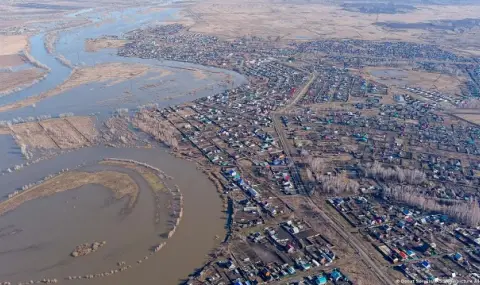A new catastrophe threatens the flooded areas in Russia's Kurgan region: the incoming waters flooded abandoned uranium mines, and radioactive substances leaked into the Tobol River, which is also used for drinking purposes.
An insidious, invisible danger stalks the people of Russia's Kurgan Region, 1,700 kilometers east of Moscow. The huge floods in the country not only flooded tens of thousands of houses and made hundreds of thousands of people flee - they seriously threaten the harvest, and now there is talk of a radioactive danger. Atomic physicist Andrei Osharovsky carefully examines photographic material from the region that is available to the general public.
„I talked to people there who claim that the water level is about a meter and a half higher than usual," says the expert from the NGO "Social-Ecological Union" in an interview with the German public media ARD. This observation is also confirmed by satellite images. The danger stems from old boreholes, part of a Soviet-era experimental mining survey. "Drilling was done there in the 1980s," says Osharovski.
Controversial uranium mining method
The nuclear expert is referring to studies to discover uranium deposits. There are thousands of such wells in the Kurgan region. Many have been sealed, but just as many are crumbling, rusting and falling apart. Now some of these boreholes are covered by the floods. The greatest danger comes from a way of extracting uranium at the time, which from today's point of view can be cautiously called extremely short-sighted.
„Usually, after mining the ore from a depth of 400 meters, the uranium is chemically extracted from it. Instead, however, extraction also took place underground, as it was cheaper that way. At the same time, however, this makes the process more dangerous," explains Osharovski. In this technology, dilute sulfuric acid is injected into the underground ore, with the help of which a uranium solution is distilled. "The idea is to then pump this uranium solution to the surface, then filter out the pure uranium," says the nuclear physicist. But some of the poisoned, radioactive mud remains underground – and only with a great deal of luck, he adds.
„A few years ago, I checked these wells, which should officially be sealed,", Osharovski told ARD. According to him, even then, even on perfectly dry days, underground water seeped into the ground – and not only water. “It was coming from an underground uranium mine where the uranium was extracted with acid. "With the help of my measuring equipment, I found contamination around every well I knew about," says the expert.
Uranium salts are highly toxic and radioactive
The Tobol River, which burst its banks as a result of the floods and flooded some of these boreholes, is the main source of drinking water for about 300,000 people in the city of Kurgan. The uranium salts that spread the waters are not only highly poisonous – they are also radioactive, Osharovski warns. “These underground mines are now flooded and there is no way the uranium will end up in the river," he says. And he specifies that it is a very low concentration, but it still goes into the drinking water.
„We are talking about the so-called "collective dose", when a large number of people are exposed to low amounts of radioactive load, the expert explains. Some of them absorb uranium through drinking water and fall victim to internal radiation, which is much more dangerous than external radiation. “No one is saying that anyone who drinks water with a low concentration of uranium is necessarily going to get sick and die. But when 10,000 people drink such water, a few dozen of them are likely to have health problems."
From "Rosatom" downplay the danger
Environmentalists have long warned about the dangers of uranium mining. The Russian Nuclear Energy Agency “Rosatom" already dismissed the warnings and called them “radiophobia," which went hand in hand with ignorance. When asked about the new uranium mines, the agency replied that they are all located higher than the current water level, ARD correspondent in Moscow Frank Eishman informed.
